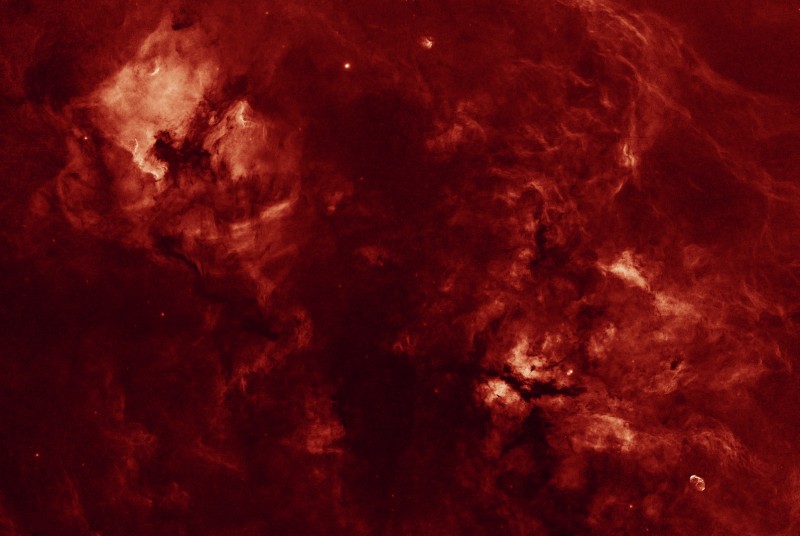
|
Credit & Copyright: Igor Chekalin
Explanation:
The sky is full of hydrogen, though it can take a
sensitive camera and telescope to see it.
For example, this twelve-degree-wide view of the
northern part
of the constellation
Cygnus
reveals cosmic clouds of
hydrogen gas
along the plane
of our Milky Way galaxy.
The mosaic of
telescopic images was recorded through an
h-alpha filter that transmits only visible red light from
glowing hydrogen atoms.
Further digital processing has removed most of what is left
of the myriad, point-like Milky Way stars from the scene, though
bright Deneb, alpha star of
Cygnus and head of the Northern Cross, remains near top center.
Recognizable bright nebulae include
NGC 7000 (North America Nebula), and
IC 5070 (Pelican Nebula) at the upper left with
IC 1318 (Butterfly Nebula) and
NGC 6888 (Crescent Nebula) at lower right --
but others can be found throughout the wide field.
Want the stars back? Just slide your cursor over the picture.
digg_url = 'http://apod.nasa.gov/apod/ap080424.html'; digg_skin = 'compact';
|
January February March April May June July August September October November December |
| ||||||||||||||||||||||||||||||||||||||||||||||||
NASA Web Site Statements, Warnings, and Disclaimers
NASA Official: Jay Norris. Specific rights apply.
A service of: LHEA at NASA / GSFC
& Michigan Tech. U.
Based on Astronomy Picture
Of the Day
Publications with keywords: Cygnus - emission nebula
Publications with words: Cygnus - emission nebula
See also:
- APOD: 2025 September 19 Á The NGC 6914 Complex
- APOD: 2025 September 10 Á The Great Lacerta Nebula
- APOD: 2025 July 21 Á Cats Paw Nebula from Webb Space Telescope
- APOD: 2025 July 16 Á The Rosette Nebula from DECam
- APOD: 2025 July 5 Á Ou4: The Giant Squid Nebula
- APOD: 2025 June 26 Á The Seagull Nebula
- NGC 6164: A Dragon s Egg
